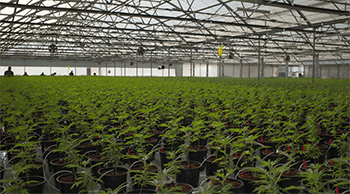Glass House Farms Expands Into New 355,000-Sq.-Ft. Greenhouse Space
Marijuana Industry News March 13, 2020 MJ Shareholders
Glass House Farms has completed its 355,000-sq.-ft. greenhouse expansion in the Carpinteria Valley, northwest of Los Angeles, bringing the company’s total greenhouse space to 505,000 square feet. The new facility marks a 34-month process, from buying the property to completing the first harvest, Glass House Group President Graham Farrar tells Cannabis Business Times.

Courtesy of Glass House Farms
“You have this vision in your head of how things are going to work, and you build it all, invest tens of millions of dollars and three years of time, and you hope you’re right. So far, knocking on wood, six harvests in now and it looks absolutely beautiful,” he says.
Quality, consistency and efficiency are the three pillars that guided this expansion, he adds. At the new greenhouse, employees are no longer handling one plant at a time. The crop is moved via rolling trays and rail-track system, allowing the company to hit six harvests per year at the new facility (as opposed to the 4.8 they’d ramped up to at the first greenhouse). The Glass House team took the controlled-environment principles of an indoor grow and applied them to a massive greenhouse space, leaning toward higher plant density, smaller plants and faster harvest—all scaled up to 10 acres.
“The things that for the last five years had been bugging me, that I wish were better about the first farm are now better at the second farm. The efficiency, the scale, the quality,” he says.
In practical terms, the new greenhouse multiplies Glass House’s existing square footage by 2.4 times. But, more important, it multiplies the company’s existing cultivation canopy by 3.5 times. This is crucial, Farrar says, as the California cannabis market is facing a supply shortage in the legal, licensed marketplace. Illicit market cannabis sales continue to outpace legal spending in California, meaning companies with the increased capacity to grow cannabis are on the front lines of the state industry’s ability to respond.
“One of the things that not everybody realizes is that there’s less supply in the California market today than there was in 2018, which was probably less supply than there was in 2017,” he says. And while the legal, compliant market continues to develop, industry observers worry that the illicit market is outpacing those licensed retail sales.
As the California cannabis licensing agencies work to flip temporary licenses to more permanent licenses, there remains a gap between cultivation capacity and retail capacity. Demand is high, Farrar says, pointing to the aggregate sales between legal and illegal markets, but licensed dispensary capacity isn’t meeting it. But it’s inevitable, he believes, that California will get there.
That’s where the Glass House expansion really comes into play: Supply is going to need to catch up to that demand in California. And where the licensing process will roll onward in time, the cultivators supporting the retail side of the business will need to ensure timely, high-quality products along the way. “So, really, what we’re doing is spending up for the demand that’s here today and the demand that’s going to be far outstripped tomorrow,” he says. “To me, that’s the exciting part.”
MJ Shareholders
MJShareholders.com is the largest dedicated financial network and leading corporate communications firm serving the legal cannabis industry. Our network aims to connect public marijuana companies with these focused cannabis audiences across the US and Canada that are critical for growth: Short and long term cannabis investors Active funding sources Mainstream media Business leaders Cannabis consumers











